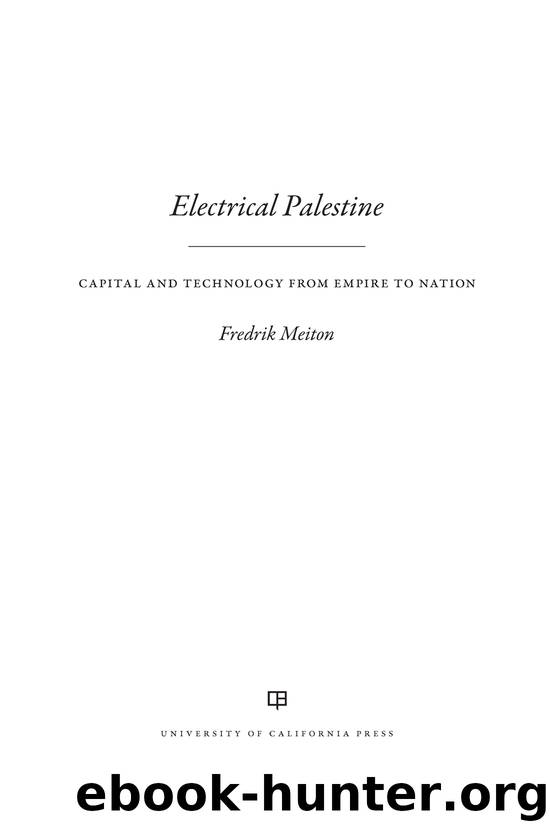Electrical Palestine by Meiton Fredrik;

Author:Meiton, Fredrik;
Language: eng
Format: epub
ISBN: 9780520968486
Publisher: University of California Press
JEWISH INDUSTRY
By 1930, labor Zionism had achieved the dominant position in the politics of the Yishuv that it was going to occupy well into Israeli statehood. While the rhetorical focus of the movement was on agriculture, something that most scholars have since echoed, industry was a prominent feature of the labor Zionist state-building project from the start. Commercial concessions, especially for various public works projects, were an early and prominent concern for the Zionist movement. With the growth of the Yishuv, the desire for industrialization grew too, since it was the only viable means of sustaining the large and quickly growing population. Reports produced by various Zionist bodies, such as Keren Hayesod’s statistical abstracts, were at pains to stress Palestine’s industrial growth and to link it to Jewish immigration. Its report from 1929 lauded the fact that industry was a large and growing item in Palestine’s export balance. In an early expression of the growing trend of ethnicizing economic activity, the statistical abstract of 1929 also noted that “industrial labour in the generally accepted sense of the term only exists among the Jewish population.” In this report, as in the discussions generally, electrification occupied pride of place in this largely overlooked arena of intense Zionist settlement activity: “The erection, by the Palestine Electric Corporation, of the electric power stations in Jaffa-Tel Aviv, Haifa and Tiberias was chiefly responsible for this extraordinarily speedy development. . . . The possibility of obtaining cheap current will certainly give an all-round strong impetus to industrial development.”5
The power company itself, during the first ten years of operation, focused almost exclusively on industry. By its own design, it was the single largest source of revenue for the company through the 1930s. In accordance with the reigning wisdom among large-systems builders, the tariffs were calibrated such that rates for industry were significantly lower than for private consumption.6 In effect, then, private consumers subsidized industrial development.
The rapid growth of “Jewish” industry was evident already by the late 1920s. By 1928, 2,270 power-driven machines were at work in factories, employing 18,000 people, including about one-tenth of the Jewish workforce.7 The largest factories were located in ethnically mixed Haifa, Jewish Tel Aviv, and Arab Jaffa. Of these, Jaffa was already a distant third.8 The vision for Haifa as an industrial hub—an essential prerequisite for which, as demonstrated earlier, was the provision of large amounts of electric power—was fast becoming reality. Haifa experienced the largest growth of all the towns of mandatory Palestine: its population more than doubled in the course of the 1930s, from 50,000 to 106,000 inhabitants. In a clear indication of the close relationship between electrified space, industrial space, and Jewish space, almost the entire population increase (50,000 of 56,000) was composed of Jews.9 In the late 1920s, oil companies began to establish facilities in the town, providing a considerable boost to energy consumption.10
The growth of the power system played a critical part in furthering industrial expansion. In the years leading up to the completion of the Naharayim
Download
This site does not store any files on its server. We only index and link to content provided by other sites. Please contact the content providers to delete copyright contents if any and email us, we'll remove relevant links or contents immediately.
| Arms Control | Diplomacy |
| Security | Trades & Tariffs |
| Treaties | African |
| Asian | Australian & Oceanian |
| Canadian | Caribbean & Latin American |
| European | Middle Eastern |
| Russian & Former Soviet Union |
The Secret History by Donna Tartt(18152)
The Social Justice Warrior Handbook by Lisa De Pasquale(11950)
Thirteen Reasons Why by Jay Asher(8449)
This Is How You Lose Her by Junot Diaz(6430)
Weapons of Math Destruction by Cathy O'Neil(5825)
Zero to One by Peter Thiel(5487)
Beartown by Fredrik Backman(5348)
The Myth of the Strong Leader by Archie Brown(5236)
The Fire Next Time by James Baldwin(5015)
How Democracies Die by Steven Levitsky & Daniel Ziblatt(4950)
Promise Me, Dad by Joe Biden(4907)
Stone's Rules by Roger Stone(4852)
100 Deadly Skills by Clint Emerson(4686)
A Higher Loyalty: Truth, Lies, and Leadership by James Comey(4546)
Rise and Kill First by Ronen Bergman(4542)
Secrecy World by Jake Bernstein(4387)
The David Icke Guide to the Global Conspiracy (and how to end it) by David Icke(4376)
The Farm by Tom Rob Smith(4320)
The Doomsday Machine by Daniel Ellsberg(4241)
